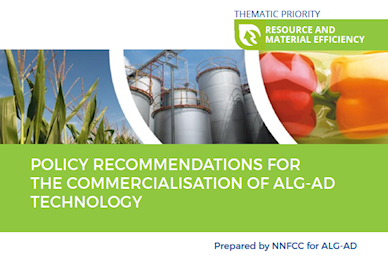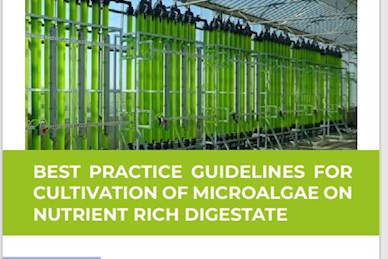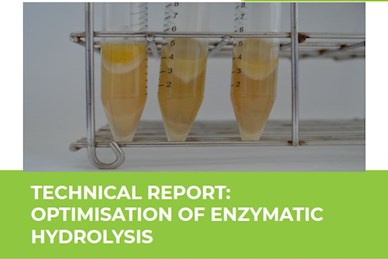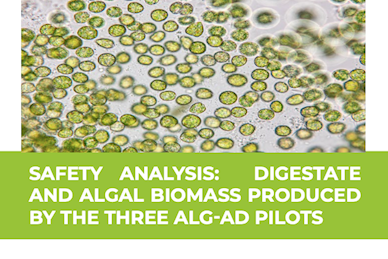THE ALG-AD PROJECT REPORTS AND DELIVERABLES

The “Regulatory review on the use of digestate to cultivate algal biomass for animal feed” is now available ! The bioeconomy consultants NNFCC identified the key European legislations applicable to the ALG-AD value chain, highlighting the main challenges to the technology development from a regulatory point of view.
The “Regulatory review on the use of digestate to cultivate algal biomass for animal feed” is now available! The bioeconomy consultants NNFCC identified the key European legislation applicable to the ALG-AD value chain, highlighting the main challenges to the technology development from a regulatory point of view.
Please, register below to download the full report.

Throughout the EU, anaerobic digestion (AD) is widely used as an effective means of managing food waste, livestock waste and other agricultural wastes via their conversion into biogas and nutrient-rich digestate (NRD). Whilst biogas is the primary product of this process, digestate is widely recognised as a valuable by-product and is used across the continent in fertiliser applications. Spreading of digestate is regulated as it can have negative and potentially damaging impacts on the environment, with the most significant risk being eutrophication of water bodies. Therefore, strict limits are imposed on the use of fertilisers around Europe and it is often not possible to return all digestate produced in AD facilities back to land, thus causing a build-up of material with no alternative application.
Throughout the EU, anaerobic digestion
(AD) is widely used as an effective means of
managing food waste, livestock waste and other
agricultural wastes via their conversion into biogas
and nutrient-rich digestate (NRD). Whilst biogas
is the primary product of this process, digestate is
widely recognised as a valuable by-product and is
used across the continent in fertiliser applications.
The spreading of digestate is regulated as it can have
negative and potentially damaging impacts on the
environment, with the most significant risk being
eutrophication of water bodies. Therefore, strict
limits are imposed on the use of fertilisers around
Europe and it is often not possible to return all
digestate produced in AD facilities back to land, thus
causing a build-up of material with no alternative
application.
The Interreg North-West Europe ALG-AD project
intends to integrate NRD-grown microalgae
cultivation systems with existing AD facilities, to
create value from Nutrient-Rich Digestate (NRD) that
is produced in excess of that permitted for landspreading,
and therefore currently has no industrial
application. Soluble nutrients contained within
digestate could be used to feed microalgae, which
in turn, will be used as a sustainable protein source
for animal feed.
This study examines the EU legislation across the
entire microalgae production value chain, focusing
first on how the requirements apply to the use of
microalgae as a ‘feed material’, the main market
being targeted by ALG-AD, before investigating
the regulatory framework for accessing alternative
markets and drawing together a series of policy
recommendations to address the main barriers
identified. The report is intended to inform the project
partners initially, then a broader set of stakeholders
and end-users with an interest in this value chain

PART1: BEST PRACTICES FOR THE TREATMENT AND PREPARATION OF NUTRIENT-RICH DIGESTATE FOR ALGAL CULTIVATION
This document is a compilation of Best Practices recommendations and considerations for the preparation of nutrient-rich digestate (NRD) with the purpose to be used as a nutrient source in microalgae cultivation systems. This document is part of the INTERREG North-West Europe funded ALG-AD project aiming to combine anaerobic digestion (AD) and algal cultivation technologies to remediate nutrient-rich digestate currently produced in excess in the region. In this report, best practices are presented for preparing NRD, including health and safety procedures, characterisation of the digestate with an emphasis on key parameters and recommendations for analysis, treatment of the digestate to facilitate integration into microalgal cultivation systems and reaching optimal nutrient concentrations for microalgal growth. The document draws on experiments and trials conducted on digestate provided by three anaerobic digestion plants in the United Kingdom, Belgium and France and additional findings can be found in Fernandes et al., 2020

PART2 BEST PRACTICES FOR OPTIMUM NUTRIENT REMOVAL AND ALGAL CULTIVATION
This document is an output of the INTERREG North-West Europe funded ALG-AD project. The document reports the results and recommendations developed through the operation of ALG-AD technology at three industrial pilot sites in North-West Europe (United Kingdom, Belgium and France). The ALG-AD technology combines anaerobic digestion (AD) and microalgal cultivation technologies. The technology was developed to take excess nutrient-rich digestate waste produced from anaerobic digestion of food and farm to cultivate algal biomass for animal feed and other products. The excess nutrient-rich digestate (NRD) is defined as digestate which is prohibited under EU legislation from being returned to land. The document reports guidelines and best practices, and associated considerations, recommendations and conclusions drawn from the set-up and running of the large-scale cultivation facilities at the three pilot sites. The cultivation of microalgae using NRD, including maximising uptake of nutrients and biomass production, and the downstream processing of the algal biomass is covered.

This document is a technical report detailing the methods required to extract oils and peptides
from Thraustochytrids. This document is part of the INTERREG North West Europe funded ALGAD
project aiming to combine anaerobic digestion (AD) and microalgal cultivation technologies
to remediate nutrient-rich digestate currently produced in excess in the area.
The main objective of this report is to show how this scientific task was carried out in the laboratory
and at the pilot facilities based at industrial locations. The document draws conclusions
and recommendations from laboratory and large-scale trials conducted at the ALG-AD project
investment site in France.
to download a full version, please use this link

Keita, A, Le Marechal, C, Poisson, V, Blanchard, Y. (2021). O Safety analysis carried out by Anses in the ALG-AD Project. Public Output report of the ALG-AD project, Swansea, November 2021, 19 pages.
This document is a technical report detailing the methods applied to conduct safety analysis on the digestates and microalgal biomass produced as part of the ALG-AD project. This document is an output of the INTERREG North West Europe funded ALG-AD project aiming to combine anaerobic digestion (AD) and microalgal cultivation technologies to remediate nutrient-rich digestate currently produced in excess in the area.
The main objective of this report is to document the methodology and results of the safety analysis conducted on the digestate and biomass produced at the three pilot facilities based at industrial locations in the UK, France and Belgium. The document draws conclusions and recommendations.
to download a full version of the report, please use this ALG-AD Safety Analysis: Digestate and Algal Biomass Produced by The Three ALG-AD Pilots - Biorefine Cluster Europe
